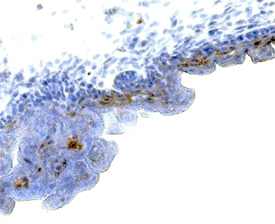Mouse FGF-4 Antibody Summary
-21, -23, rhFGF acidic, rhFGF basic, rhFGF-3, -4, -5, -9, -11, -12, -13, -18, -19, or -22 is observed.
Ala30-Leu202
Accession # NP_034332
Applications
Please Note: Optimal dilutions should be determined by each laboratory for each application. General Protocols are available in the Technical Information section on our website.
Scientific Data
 View Larger
View Larger
FGF‑4 in Mouse Embryo. FGF-4 was detected in immersion fixed frozen sections of mouse embryo (13 d.p.c.) using Rat Anti-Mouse FGF-4 Monoclonal Antibody (Catalog # MAB5846) at 25 µg/mL overnight at 4 °C. Tissue was stained using the Anti-Rat HRP-DAB Cell & Tissue Staining Kit (brown; Catalog # CTS017) and counterstained with hematoxylin (blue). Specific staining was localized to epithelial cells. View our protocol for Chromogenic IHC Staining of Frozen Tissue Sections.
Reconstitution Calculator
Preparation and Storage
- 12 months from date of receipt, -20 to -70 °C as supplied.
- 1 month, 2 to 8 °C under sterile conditions after reconstitution.
- 6 months, -20 to -70 °C under sterile conditions after reconstitution.
Background: FGF-4
FGF-4 (fibroblast growth factor-4), also known as FGF-K or K-FGF (Kaposi’s sarcoma-associated FGF), is a 25 kDa secreted, heparin-binding member of the FGF family (1, 2). The mouse FGF-4 cDNA encodes 202 amino acids (aa) with a 29 aa signal sequence and a 173 aa mature protein with an FGF homology domain that contains a heparin binding region near the C-terminus (2). Mature mouse FGF-4 shares 87%, 90%, 87% and 85% aa identity with human, rat, canine and bovine FGF‑4, respectively. Human FGF-4 has been shown to exhibit cross species activity. Expression of FGF-4 and its receptors, FGF R1c, 2c, 3c and 4, is spatially and temporally regulated during embryonic development (1, 3). Its expression in the trophoblast inner cell mass promotes expression of FGF R2, and is required for maintenance of the trophectoderm and primitive endoderm (3‑5). Later in development, FGF-4 works together with FGF-8 to mediate the activities of the apical ectodermal ridge, which direct the outgrowth and patterning of vertebrate limbs (3, 6‑9). FGF-4 is proposed to play a physiologically relevant role in human embryonic stem cell self-renewal. It promotes stem cell proliferation, but may also aid differentiation depending on context and concentration, and is often included in embryonic stem cell media in vitro (10‑12). A C-terminally truncated 15 kDa isoform that opposes full-length FGF-4 and promotes differentiation is endogenously expressed in human embryonic stem cells. FGF-4 is mitogenic for fibroblasts and endothelial cells in vitro and has autocrine transforming potential (13). It is a potent angiogenesis promoter in vivo and has been investigated as therapy for coronary artery disease (14).
- Reuss, B. and O. von Bohlen und Halbach (2003) Cell Tiss. Res. 313:139.
- Hebert, J.M. et al. (1990) Dev. Biol. 138:454.
- Niswander, L. and G.R. Martin (1992) Development 114:755.
- Feldman, B. et al. (1995) Science 267:246.
- Goldin, S.N. and V.E. Papaioannou (2003) Genesis 36:40.
- Sun, X. et al. (2002) Nature 418:501.
- Boulet, A.M. et al. (2004) Dev. Biol. 273:361.
- Yu, K and D.M. Ornitz (2008) Development 135:483.
- Mariani, F.V. et al. (2008) Nature 453:401.
- Johannesson, M. et al. (2009) PLoS ONE 4:e4794.
- Kunath, T. et al. (2007) Development 134:2895.
- Mayshar, Y. et al. (2008) Stem Cells 26:767.
- Hajitou, A. et al. (1998) Oncogene 17:2059.
- Flynn, A. and T. O’Brien (2008) IDrugs 11:283.
Product Datasheets
FAQs
No product specific FAQs exist for this product, however you may
View all Antibody FAQsReviews for Mouse FGF-4 Antibody
There are currently no reviews for this product. Be the first to review Mouse FGF-4 Antibody and earn rewards!
Have you used Mouse FGF-4 Antibody?
Submit a review and receive an Amazon gift card.
$25/€18/£15/$25CAN/¥75 Yuan/¥2500 Yen for a review with an image
$10/€7/£6/$10 CAD/¥70 Yuan/¥1110 Yen for a review without an image




